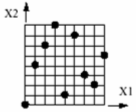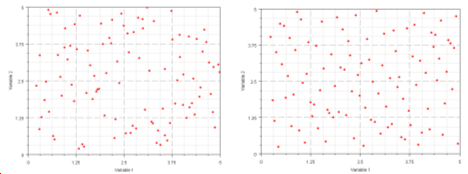Latin Hypercube |

|

|

|

|
|
Latin Hypercube |

|

|

|

|
A square grid containing sample positions is a Latin square if, and only if, there is only one sample in each row and each column. A Latin Hypercube DOE, categorized as a space filling DOE, is the generalization of this concept to an arbitrary number of dimensions.
When sampling a design space of N variables, the range of each variable is divided into M equally probable intervals. M sample points are then placed to satisfy the Latin Hypercube requirements. As a result, all experiments have unique levels for each input variable and the number of sample points, M, is not a function of the number of input variables.


Latin Hypercube (left) and Hammersley (right) for 100 runs
| • | To get a good quality fitting function, a minimum number of runs should be evaluated. (N+1)(N+2)/2 runs are needed to fit a second order polynomial, assuming that most output responses are close to a second order polynomial within the commonly used input variable ranges of -+10%. An additional number of runs equal to 10% is recommended to provide redundancy, which results in more reliable post-processing. As a result, this equation is recommend to calculate the number of runs needed or a minimum of 1.1*(N+1)(N+2)/2 runs. |
| • | The structure of a Latin Hypercube run matrix ensures that the runs are orthogonal. Orthogonality is desirable because it is less likely to result in singularities when creating Least Squares fits. |
| • | Any data in the inclusion matrix is combined with the run data for post-processing. Any run matrix point which is already part of the inclusion data will not be rerun. |
In the Specifications step, you can change the following settings of Latin Hypercube from the Settings tab.
Parameter |
Default |
Range |
Description |
Number of runs(npt) |
|
> 0 integer |
Number of new designs to be evaluated. |
Random Seed(iseed) |
1 |
Integer 0 to 10000 |
Controlling repeatability of runs depending on the way the sequence of random numbers is generated. 0 random (non-repeatable) > 0 triggers a new sequence of pseudo-random numbers, repeatable if the same number is specified. |
Use Inclusion Matrix |
false |
true or false |
Concatenation without duplication between the inclusion and the generated run matrix. |